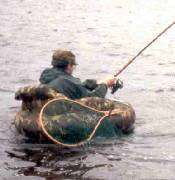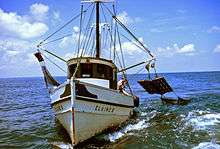Monofilament fishing line
Monofilament fishing line (shortened to just mono) is fishing line made from a single fiber of plastic, as opposed to braided fishing line constructed from multiple fibers of material. Most fishing lines are now monofilament because monofilament fibers are cheap to produce and are produced in a range of diameters which have different tensile strengths (called "tests" after the process of tensile testing). Monofilament line is also manufactured in different colors, such as clear, white, green, blue, red, and fluorescent.
Monofilament is made by melting and mixing polymers and then extruding the mixture through tiny holes, forming strands of line, which is then spun into spools of various thicknesses. The extrusion process controls not only the thickness of the line but its test as well.
History
DuPont made public in 1938 that their company had invented nylon.[1] This new invention was the first synthetic fiber, fabrics that are commonly used in textiles today.[2] In 1939, DuPont began marketing nylon monofilament fishing lines; however, braided Dacron lines remained the most used and popular fishing line for the next two decades, as early monofilament line was very stiff or "wiry", and difficult to handle and cast. Early monofilament did, however, have good knot strength and very low visibility to the fish, creating a small loyal following among fishermen. In 1959 DuPont introduced Stren, a thinner and much softer monofilament line that could be used in a large range of reels, including newly introduced spinning and spin casting tackle. Stren's monofilament lines soon became a favorite with many fishermen because of its overall ease of use and it spawned a whole host of imitators.
New materials, e.g., Spectra or Dyneema, are finding growing usage as fishing lines. Polyvinylidene fluoride (also sold as fluorocarbon or PVDF) is very much like nylon monofilament, but has several advantages. Optical density is lower, which makes the line less easily discernible. The surface is harder so it is more resistant to sharp fish teeth and wear. Furthermore, PVDF does not take up water and it is resistant to UV-light. It is denser than nylon, too, which makes it sink faster.
Dyneema is also becoming very popular and it is much stronger, but it is used mostly as a braided fishing line. Because the elastic stretching is only a fraction of that of nylon monofilament, the contact with fish or bait is more direct. It is often used for deep water fishing from boats because lower diameters are used, which give less resistance to currents, and the low stretch makes bites easily detectable.
Use
Monofilament fishing line is used in a huge variety of fishing applications.
Monofilament is not advisable for deepwater fishing, since it can absorb water, resulting in loose knots, and its sensitivity can decrease when it is wet. Monofilament degrades with time and can weaken when exposed to heat, sunlight, and/or salt water. When stored on a spool for a long time, it may come off the fishing reel in coils or loops. It is advisable to change monofilament line at regular intervals to prevent degradation.[3]
Non-fishing uses
Monofilament fishing line is used sometimes in medicine to test the sense of touch.[4]
The transparency of monofilament fishing line makes it desirable for special effects where objects need to look like they are floating unsupported.[5]
It has also been used for string trimmers, musical instrument strings, sewing thread and bent in the shape of a staple for use as a septum piercing retainer.
Environmental impact

Discarded monofilament lines can present serious environmental problems. These lines are extremely difficult to spot when submerged in water, and fish, birds, and other marine life can easily become entangled, causing starvation, amputation, and death. Ingestion is also a serious threat to wildlife. Monofilament lines also present a risk to swimmers and scuba divers. The breakdown of lines, especially in string trimmers, leads to microplastics which may cause starvation or poisoning of organisms in soil or water.
For these reasons, programs have been started to recycle fishing line, to keep it out of the environment. Specialized containers have been designed to collect fishing line for recycling.
See also
References
- History of Nylon Archived 21 June 2008 at the Wayback Machine US Patent 2,130,523 'Linear polyamides suitable for spinning into strong pliable fibers', U.S. Patent 2,130,947 'Diamine dicarboxylic acid salt' and U.S. Patent 2,130,948 'Synthetic fibers', all issued 20 September 1938
- "Dupont Heritage, 1935:Nylon". Archived from the original on 30 December 2007. Retrieved 31 December 2007.
- Types of Fishing Lines Archived 3 April 2007 at the Wayback Machine
- Medicalmonofilament.com Archived 12 May 2006 at the Wayback Machine
- Creating Special Effects for 2001: A Space Odyssey
External links
- MRRP Monofilament Recovery and Recycling Program
- How Much Monofilament Fishing Line Fits On A Reel

